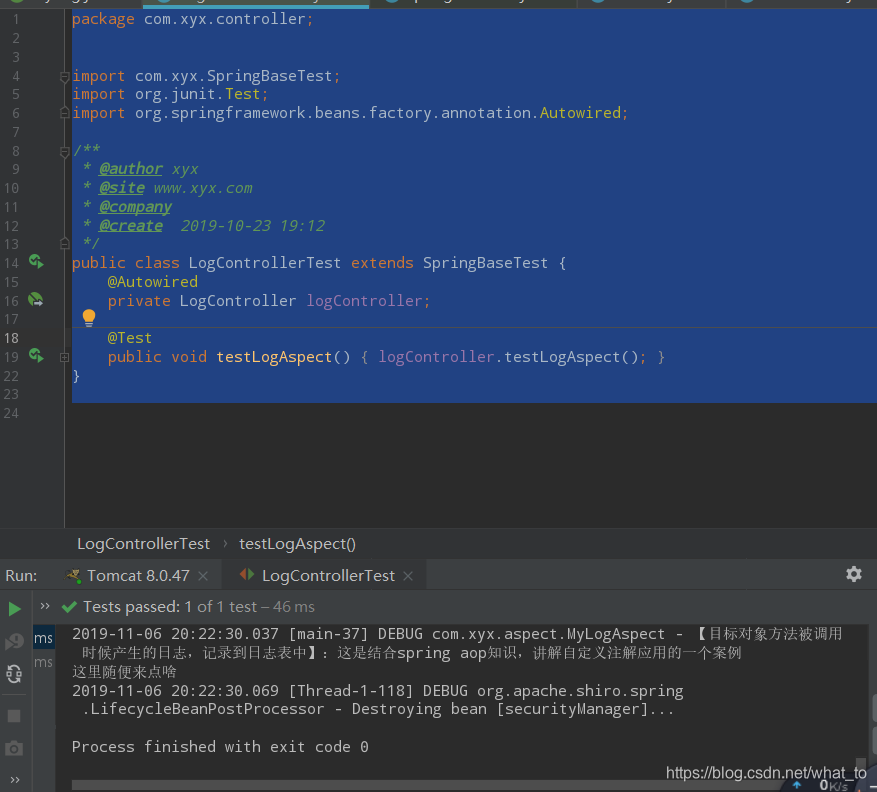Java自定义注解(1)
1、Java注解简介
1. Java注解(Annotation)
Java注解是附加在代码中的一些元信息,用于一些工具在编译、
运行时进行解析和使用,起到说明、配置的功能。
注解相关类都包含在java.lang.annotation包中。
2. Java注解分类
2.1 JDK基本注解
2.2 JDK元注解
2.3 自定义注解
3. JDK基本注解
3.1 @Override
重写
3.2 @Deprecated
已过时
3.3 @SuppressWarnings(value = "unchecked")
压制编辑器警告
2、Java元注解
作用:元注解用于修饰其他的注解
@Retention
@Retention:定义注解的保留策略
@Retention(RetentionPolicy.SOURCE) //注解仅存在于源码中,在class字节码文件中不包含
@Retention(RetentionPolicy.CLASS) //默认的保留策略,注解会在class字节码文件中存在,但运行时无法获得,
@Retention(RetentionPolicy.RUNTIME) //注解会在class字节码文件中存在,在运行时可以通过反射获取到
@Target
@Target:指定被修饰的Annotation可以放置的位置(被修饰的目标)
@Target(ElementType.TYPE) //接口、类
@Target(ElementType.FIELD) //属性
@Target(ElementType.METHOD) //方法
@Target(ElementType.PARAMETER) //方法参数
@Target(ElementType.CONSTRUCTOR) //构造函数
@Target(ElementType.LOCAL_VARIABLE) //局部变量
@Target(ElementType.ANNOTATION_TYPE) //注解
@Target(ElementType.PACKAGE) //包
注:可以指定多个位置,例如:
@Target({ElementType.METHOD, ElementType.TYPE}),也就是此注解可以在方法和类上面使用
@Inherited
@Inherited:指定被修饰的Annotation将具有继承性
@Documented
@Documented:指定被修饰的该Annotation可以被javadoc工具提取成文档.
3、自定义注解
注解分类(根据Annotation是否包含成员变量,可以把Annotation分为两类):
标记Annotation:
没有成员变量的Annotation; 这种Annotation仅利用自身的存在与否来提供信息
元数据Annotation:
包含成员变量的Annotation; 它们可以接受(和提供)更多的元数据;
如何自定义注解?
使用@interface关键字, 其定义过程与定义接口非常类似, 需要注意的是:
Annotation的成员变量在Annotation定义中是以无参的方法形式来声明的, 其方法名和返回值类型定义了该成员变量的名字和类型,
而且我们还可以使用default关键字为这个成员变量设定默认值;
注意:只有名字为“value”属性,赋值时可以省略属性名
P1:
Demo1Test
package com.xyx.annotation.p1;
import com.xyx.annotation.p2.Demo1;
import com.xyx.annotation.p2.MyAnnotation2;
import org.junit.Test;
/**
* @author xyx
* @site www.xyx.com
* @company
* @create 2019-10-23 18:44
*/
public class Demo1Test {
@Test
public void list() throws Exception {
// 获取类上的注解
MyAnnotation1 annotation1 = Demo1.class.getAnnotation(MyAnnotation1.class);
System.out.println(annotation1.name());//abc
// 获取方法上的注解
MyAnnotation2 myAnnotation2 = Demo1.class.getMethod("list").getAnnotation(MyAnnotation2.class);
System.out.println(myAnnotation2.model());//Read
}
@Test
public void edit() throws Exception {
MyAnnotation3 myAnnotation3 = Demo1.class.getMethod("edit").getAnnotation(MyAnnotation3.class);
for (TranscationModel model : myAnnotation3.models()) {
System.out.println(model);//Read,Write
}
}
}
MyAnnotation1
package com.xyx.annotation.p1;
import java.lang.annotation.*;
/**
* @author xyx
* @site www.xyx.com
* @company
* @create 2019-10-23 18:40
*
* MyAnnotation1注解可以用在类、接口、属性、方法上
* 注解运行期也保留
* 不可继承
*/
@Target({ElementType.TYPE, ElementType.FIELD,ElementType.METHOD})
@Retention(RetentionPolicy.RUNTIME)
@Documented
public @interface MyAnnotation1 {
String name();
}
MyAnnotation3
package com.xyx.annotation.p1;
import java.lang.annotation.*;
/**
* @author xyx
* @site www.xyx.com
* @company
* @create 2019-10-23 18:42
*
* MyAnnotation3注解可以用在方法上
* 注解运行期也保留
* 可继承
*/
@Target(ElementType.METHOD)
@Retention(RetentionPolicy.RUNTIME)
@Inherited
@Documented
public @interface MyAnnotation3 {
TranscationModel[] models() default TranscationModel.ReadWrite;
}
TranscationModel
package com.xyx.annotation.p1;
/**
* @author xyx
* @site www.javaxl.com
* @company
* @create 2019-10-23 18:41
*/
public enum TranscationModel {
Read, Write, ReadWrite
}
P2:
Demo2
package com.xyx.annotation.p2;
/**
* @author xyx
* @site www.xyx.com
* @company
* @create 2019-10-23 18:49
*
* 获取类属性上的注解属性值
*/
public class Demo2 {
@TestAnnotation(value = "这就是value对应的值_msg1", what = "这就是what对应的值_msg1")
private static String msg1;
@TestAnnotation("这就是value对应的值1")
private static String msg2;
@TestAnnotation(value = "这就是value对应的值2")
private static String msg3;
@TestAnnotation(what = "这就是what对应的值")
private static String msg4;
}
Demo2Test
package com.xyx.annotation.p2;
import org.junit.Test;
/**
* @author xyx
* @site www.xyx.com
* @company
* @create 2019-10-23 18:49
*/
public class Demo2Test {
@Test
public void test1() throws Exception {
TestAnnotation msg1 = Demo2.class.getDeclaredField("msg1").getAnnotation(TestAnnotation.class);
System.out.println(msg1.value());
System.out.println(msg1.what());
}
@Test
public void test2() throws Exception{
TestAnnotation msg2 = Demo2.class.getDeclaredField("msg2").getAnnotation(TestAnnotation.class);
System.out.println(msg2.value());
System.out.println(msg2.what());
}
@Test
public void test3() throws Exception{
TestAnnotation msg3 = Demo2.class.getDeclaredField("msg3").getAnnotation(TestAnnotation.class);
System.out.println(msg3.value());
System.out.println(msg3.what());
}
@Test
public void test4() throws Exception{
TestAnnotation msg4 = Demo2.class.getDeclaredField("msg4").getAnnotation(TestAnnotation.class);
System.out.println(msg4.value());
System.out.println(msg4.what());
}
}
MyAnnotation2
package com.xyx.annotation.p2;
import com.xyx.annotation.p1.TranscationModel;
import java.lang.annotation.*;
/**
* @author xyx
* @site www.xyx.com
* @company
* @create 2019-10-23 18:40
*
* MyAnnotation2注解可以用在方法上
* 注解运行期也保留
* 不可继承
*/
@Target(ElementType.METHOD)
@Retention(RetentionPolicy.RUNTIME)
@Documented
public @interface MyAnnotation2 {
TranscationModel model() default TranscationModel.ReadWrite;
}
TestAnnotation
package com.xyx.annotation.p2;
import java.lang.annotation.ElementType;
import java.lang.annotation.Retention;
import java.lang.annotation.RetentionPolicy;
import java.lang.annotation.Target;
/**
* @author xyx
* @site www.xyx.com
* @company
* @create 2019-10-23 18:48
*/
//@Retention(RetentionPolicy.SOURCE)
@Retention(RetentionPolicy.RUNTIME)
@Target(ElementType.FIELD)
public @interface TestAnnotation {
String value() default "默认value值";
String what() default "这里是默认的what属性对应的值";
}
P3:
Demo3
package com.xyx.annotation.p3;
/**
* @author xyx
* @site www.xyx.com
* @company
* @create 2019-10-23 19:03
*
* 获取参数修饰注解对应的属性值
*/
public class Demo3 {
public void hello1(@IsNotNull(true) String name,@IsNotNull String pwd,Integer age) {
System.out.println("hello:" + name);
}
public void hello2(@IsNotNull String name) {
System.out.println("hello:" + name);
}
}
Demo3Test
package com.xyx.annotation.p3;
import org.junit.Test;
import java.lang.reflect.Parameter;
/**
* @author xyx
* @site www.xyx.com
* @company
* @create 2019-10-23 19:04
*/
public class Demo3Test {
@Test
public void hello1() throws Exception {
Demo3 demo3 = new Demo3();
for (Parameter parameter : demo3.getClass().getMethod("hello1", String.class,String.class,Integer.class).getParameters()) {
IsNotNull annotation = parameter.getAnnotation(IsNotNull.class);
if(annotation != null){
System.out.println(annotation.value());//true
}
}
}
@Test
public void hello2() throws Exception {
Demo3 demo3 = new Demo3();
for (Parameter parameter : demo3.getClass().getMethod("hello2", String.class).getParameters()) {
IsNotNull annotation = parameter.getAnnotation(IsNotNull.class);
if(annotation != null){
System.out.println(annotation.value());//false
}
}
}
}
IsNotNull
package com.xyx.annotation.p3;
import java.lang.annotation.*;
/**
* @author xyx
* @site www.xyx.com
* @company
* @create 2019-10-23 19:02
*
* 非空注解:使用在方法的参数上,false表示此参数可以为空,true不能为空
*/
@Documented
@Target({ElementType.PARAMETER})
@Retention(RetentionPolicy.RUNTIME)
public @interface IsNotNull {
boolean value() default false;
}
4、Aop自定义注解的应用
annotation1
MyLog
package com.xyx.annotation1;
import java.lang.annotation.ElementType;
import java.lang.annotation.Retention;
import java.lang.annotation.RetentionPolicy;
import java.lang.annotation.Target;
/**
* @author xyx
* @site www.javaxl.com
* @company
* @create 2019-10-23 19:08
*/
@Target(ElementType.METHOD)
@Retention(RetentionPolicy.RUNTIME)
public @interface MyLog {
String desc();
}
controller
LogControllerTest
package com.xyx.controller;
import com.xyx.SpringBaseTest;
import org.junit.Test;
import org.springframework.beans.factory.annotation.Autowired;
/**
* @author xyx
* @site www.xyx.com
* @company
* @create 2019-10-23 19:12
*/
public class LogControllerTest extends SpringBaseTest {
@Autowired
private LogController logController;
@Test
public void testLogAspect(){
logController.testLogAspect();
}
}
service
SpringBaseTest
package com.xyx;
import com.xyx.model.Book;
import com.xyx.util.PageBean;
import org.junit.Before;
import org.junit.runner.RunWith;
import org.springframework.test.context.ContextConfiguration;
import org.springframework.test.context.junit4.SpringJUnit4ClassRunner;
/**
* @xyx
*/
@RunWith(SpringJUnit4ClassRunner.class)
@ContextConfiguration(locations={"classpath:applicationContext.xml"})
public class SpringBaseTest {
protected Book book;
protected PageBean pageBean;
@Before
public void init(){
book = new Book();
pageBean = new PageBean();
}
}
























 1945
1945

 被折叠的 条评论
为什么被折叠?
被折叠的 条评论
为什么被折叠?








